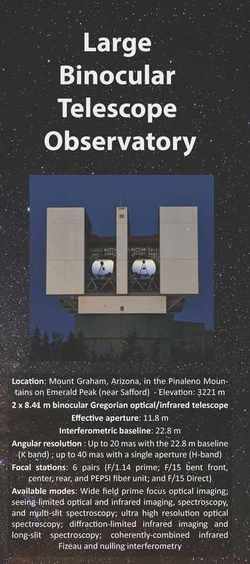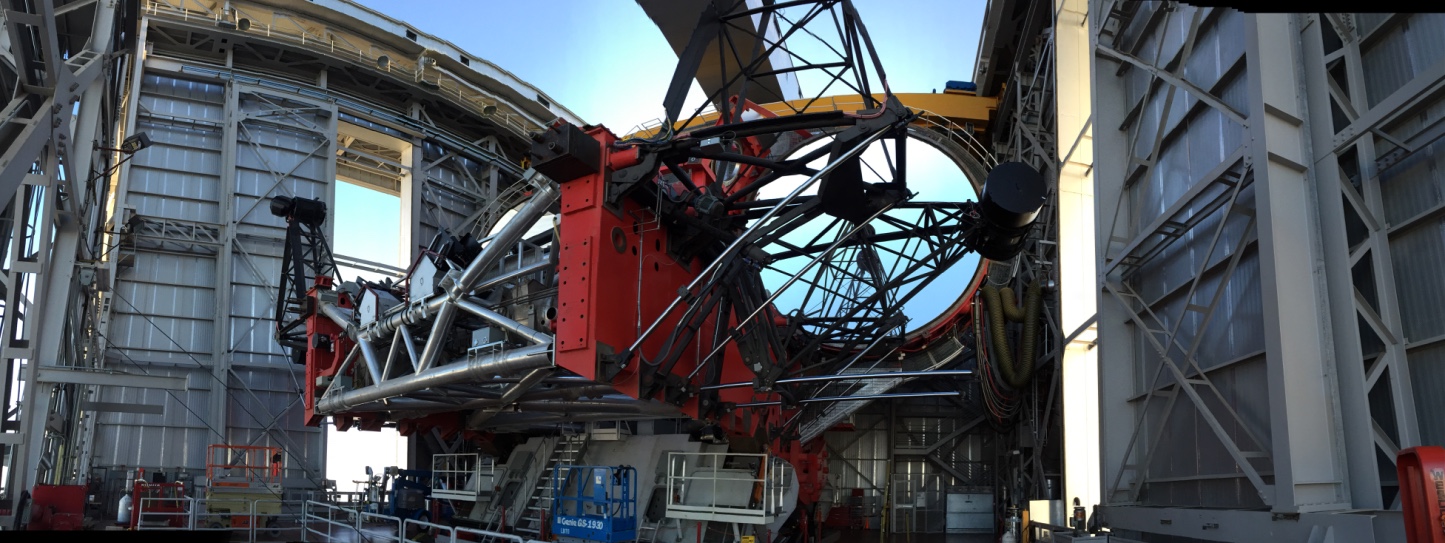About
The Observatory
The Large Binocular Telescope Observatory (LBTO) is located in southeastern Arizona near Safford in the Pinaleno Mountains on Emerald Peak at an altitude of 3200m. This area is part of the Coronado National Forest. LBTO is headquartered on the Tucson campus of the University of Arizona.
The binocular design of the Large Binocular Telescope (LBT) has two identical 8.4m telescopes mounted side-by-side on a common altitude-azimuth mounting for a combined collecting area of a single 11.8m telescope. The entire telescope and enclosure are very compact by virtue of the fast focal ratio (F/1.14) of the primary mirrors.
The two primary mirrors are separated by 14.4m center-to-center and provide an interferometric baseline of 22.8m edge-to-edge. The binocular design, combined with integrated adaptive optics utilizing adaptive Gregorian secondary mirrors to compensate for atmospheric phase errors, provides a large effective aperture, high angular resolution, low thermal background, and exceptional sensitivity for the detection of faint objects.
The LBT is an international collaboration among institutions in the United States, Italy and Germany. LBT Corporation Members are: The University of Arizona on behalf of the Arizona Board of Regents; Istituto Nazionale di Astrofisica, Italy; LBT Beteiligungsgesellschaft, Germany, representing the Max-Planck Society, The Leibniz Institute for Astrophysics Potsdam, and Heidelberg University; The Ohio State University, representing OSU, University of Notre Dame, University of Minnesota and University of Virginia (see the collaboration page for more details).

Download the LBTO Brochure

Image of the Large Binocular Telescope taken from the chamber floor – complements of Barry Rothberg, LBTO
The Mission of the Observatory
LBT is a pair of 8-m class telescopes working together as well as the first of the ELTs (Extremely Large Telescopes), able to provide the spatial resolution of a 22.7m telescope. Therefore, LBTO must offer to its users the efficiency and versatility of the current generation of 8- to 10-m telescopes while developing its interferometric capabilities to indeed become the first ELT. This dual mission is illustrated in the mission statement currently used as the basis for its development plan up to the end of the decade:
Vision:
The Large Binocular Telescope Observatory is committed to a world in which discoveries are enabled that expand knowledge and inspire all of humanity to unite in passionate exploration of the wonders of our Universe.
Mission:
The Large Binocular Telescope Observatory uses its unique astronomical capabilities to see more clearly and advance our scientific understanding of the Universe.
This duality reflects the diversity of the LBTO partnership. Some partners have a strong interest in LBTO being a laboratory to develop new technologies, while others place more emphasis on LBTO to deliver high quality data with robust scientific productivity in the same vein as the other mature 8- to 10-m class telescopes. This mission also brings the observatory unusual challenges while placing it in a unique position among the existing large facilities
The scientific interests of the LBTO partnership span the full range of modern astrophysics, from exo-planets to the high-redshift universe. This broad spectrum of interests makes the LBTO a “community observatory” with observing programs drawing on the telescope’s unique capabilities: multiplex gain from its binocular nature and high-resolution from its interferometric modes. The partners agree that the observatory will play an important role, establishing its place among the leading current astronomical facilities of the world, and anticipating ELT-class science in the forthcoming decade that precedes the arrival of the GMT/TMT/E-ELT.
LBT’s intrinsic complexity, partnership arrangements, fiscal resources, and number of instruments and capabilities available to its users must be considered when comparing the LBTO to other large telescope facilities operated by consortia such as the VLTs, Keck, Gemini, Subaru, or GTC in terms of cost and efficiency. LBTO must keep its operation costs well-contained so that it can fulfill its mission at a cost commensurate with the services it provides.

